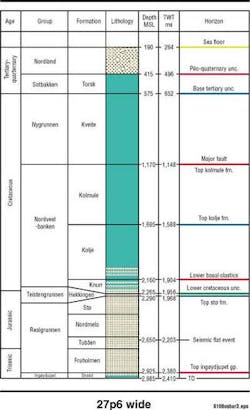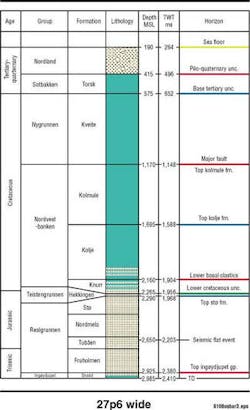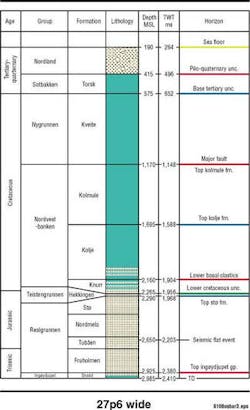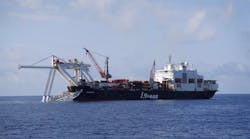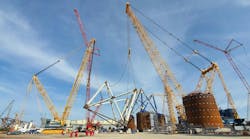A re-engineered formate brine drilling fluid system played a role in helping Norsk Agip achieve rigid environ-mental objectives in a high-profile exploration program in the Barents Sea off northern Norway. The drilling fluid system that combines an exceptional HSE (health, safety, and environmental) profile with high performance characteristics was one element in a strategy developed for a drilling campaign in sensitive ecosystems.
Two wells were completed with low environmental impacts, but also ahead of the planned drilling curve with a reduction in the amount of drill waste requiring dilution. Both of the wells were logged as discoveries.
The Goliath and Gamma discoveries are located 21 and 40 nautical miles, respectively, offshore Hammerfest, which is the northernmost incorporated city in the world. With a 25% interest, Norsk Agip was the operator for the wells drilled on blocks 7122/7 and 7019/1-1. Partners in the Goliath prospect were Phillips, Enterprise, Fortum (formerly Neste), and the Norwegian government (SDFI), while Statoil replaced Phillips for the Gamma well. At publication, Statoil ASA had taken over the state's (SFDI) shares in both licenses.
Operational challenges
Exploration activity in the Barents Sea peaked during the 1980s and steadily declined through the beginning of the last decade. To avoid a standstill in drilling activity, the Norwegian government in 1996 awarded new license concessions. The concessions included blocks 7122/7 and 7123/7 (PL 229), which were awarded in 1997. Blocks 7018/3 and 7019/1 (PL 201) were awarded in the 14th Round in 1993.
In a closely regulated environment, the Barents Sea is home to rich fishing grounds and a wealth of sea birds and marine mammals. It is believed that the plankton and assorted fauna growing further offshore at the edge of the ice pack begin the food chain for the sea. Accordingly, exploration programs must operate within stringent environmental parameters. For example, exploration drilling in the oil-bearing strata of Block 7122/7 is not permitted between January 15 and September 1, meaning Norsk Agip faced a three and one-half month drilling window.
Water depths across the Barents Sea range from 656 ft to 1,312 ft. Operators there face challenging meteorological and oceanographic conditions, such as extreme temperatures, near darkness for 24 hours (November to February), unpredictable development of polar lows that create extreme waves and winds locally. All of this is combined with a sensitive ecosystem. Owing to the on-location difficulties and logistical hurdles, pre-planning was critical in meeting both environmental and operational objectives.
Goliath and Gamma
Operationally, the objective of both wells was to investigate the hydrocarbon potential of the Middle Jurassic and the Upper Triassic sandstone reservoir series of the Realgrunnen Group. However, since Norsk Agip's prevailing goal was to drill the wells with no impairment to the environment, much of the pre-planning centered on that arena.
After the license award, the operator began laying the groundwork for Barents Sea exploration with initiation of the ice water program, in conjunction with Enterprise and then-Neste. The purpose was to improve understanding of the environmental impacts and risks associated with exploration and production as well as termination and removal activities. Study results showed no significant environmental impacts from the exploration phase, with the exception of accidental discharges from any blowout that may occur. Contingencies were designed to deal with the after effects of an underground or surface blowout.
The 2000-2001 drilling campaign was planned and prepared jointly with the NoBaLes (Norsk Barentshavet Letesamar-beid) group through several environmental studies. Agip Enterprise and Neste (AEN) started the cooperation in 1995 in preparation for the then upcoming Barents Sea round of concessions. Phillips, Mobil, Norsk Hydro, and the SDFI joined the AEN group in 1997 to form NoBaLes. Norsk Agip and its partners in NoBaLes also developed an assortment of joint studies for the drilling campaign, including environmental risk and emergency preparedness analysis, oil spill preparedness, coordinated well planning, and a joint plan for logistics and discharge permits, among others.
All of the environmental and operational considerations were formulated on the basis of waves, wind, currents, ice, snow, and sea temperatures at 100-year extremes. To allow for the timely implementation of low-temperature procedures, when temperatures dip to 5° F, developing accurate forecasts were crucial. Being relatively close to the environmentally sensitive shoreline, Norsk Agip faced particular challenges. For the drilling program, it chose an environmentally compatible drilling fluid system.
In a related issue, maintaining adequate provisions of drilling fluid and associated chemicals on-site posed the most daunting logistical challenge.
Fluid constraints
Limited drilling fluid storage was available at Hammerfest, so most supplies were shipped from the nearest full-scale base at Kristiansund, three days by boat to Hammerfest. From there, it is 20 hours by boat to the Gamma well and 10 hours to Goliath. To ensure no downtime while awaiting supplies, 50% more drilling fluid than expected to be needed was held in reserve at Hammerfest and delivered once a week.
Located in 1,253 ft water depth, Goliath was the first well to be drilled, with a planned depth of 5,791 ft TVD (true vertical depth) and a planned drilling duration of 33 days. Gamma, drilled in 623 ft water depth at a planned TVD of 9,869 ft, was targeted to be complete in 57 days. The semisubmersible Transocean Arctic, one of the few rigs in Norway suitable for drilling in Arctic conditions, was selected to drill these two wells.
Goliath and Gamma represented the first time in Norway that a sodium/potassium (Na/K) formate brine, which normally is used as a completion fluid, was used as a wellbore and reservoir drilling fluid system. Historically, other wells drilled in the Barents Sea utilized simple polymer or KCL/glycol-based drilling fluids.
Formate brines
Originally, low-solids formate brines, comprising either sodium, potassium or cesium salts of formic acid, were designed to minimize frictional pressure losses in slimhole drilling applications. In addition, their unique capability of stabilizing polymers at high temperatures made the fluids more temperature resistant than other polymer-based drilling fluids. Later, it was determined that the high densities and low corrosivity of these brines made them ideal packer fluids. The brines possess excellent HSE profiles and are compatible with reservoir fluids, providing shale and gas hydrate inhibition.
Slow drilling characterized many of the earlier wells drilled in the Barents Sea. As the Goliath and Gamma prospects would penetrate young and highly reactive shales, and in the case of the latter, very hard formations, the primary technical criteria were formulating a system that would exhibit excellent shale inhibition and lubricity.
Unlike simple polymer and KCL/glycol systems, the density of the pure potassium formate brine system can be weighted up to 13.1 lb/gal (1.57 sg) without the addition of conventional weighting agents, like barite or ilmenite. By contrast, KCL-based systems will not exceed 9.5 l/gal (1.15 sg), meaning a large volume of weighting material must be added to reach the desired density. Once the system reaches the reservoir, the additional solids pose serious risks of formation damage, while the potassium formate brine is essentially a minimally damaging solids-free system.
In keeping with environmental concerns, ilmenite was to be used if any additional weighting material was required. Doing so would eliminate the heavy metal discharges associated with barite. Technical merits aside, the potassium format brine was selected largely for its overwhelming environmental advantages. The system contained only Plonor List Category "A" chemicals, which the Norwegian Pollution Control Authority and European standard defines as naturally occurring material.
The formate itself poses minimal health risks and is biodegradable in low concentration. In higher concentrations, it prevents bacterial growth, thereby eliminating the need for toxic biocides in the fluid. Unlike Halide brines, the properties of the potassium formate brine are engineered to minimize corrosion. Furthermore, since the system was designed basically solids-free, the fluid could be reconditioned locally for re-use on subsequent wells. As with other wells drilled in the surrounding areas, a simple CMC/Bentonite/SW drilling fluid was programmed for the 36-in. and 26-in. top-hole sections. The potassium formate system was to be displaced in the 12 1/4-in. intermediate and 8 1/2-in. reservoir intervals.
Drilling performance
A 10.8 lb/gal formate brine-base system was displaced in the 12 1/4-in. section of the Goliath well at 2,263 ft, which, as with both wells, was drilled with the intention of setting the 9 5/8-in casing shoe close to the top of the expected reservoir formation. This was necessary to achieve a fracture gradient as high as possible before drilling into the reservoir.
Shortly in the drilling of the intermediate section and before the mud had been properly sheared, the bit penetrated a water-sensitive formation, causing the ensuing cuttings to become sticky and almost paste-like when coming through the shakers. The result was severe screen blinding and massive losses of whole drilling fluid.
Most of the problem with the newly formulated system was with the high-viscosity polyionic cellulose (PAC) that was incorporated in the system for fluid loss and rheology control. Instead, the PAC presented a high rheology profile and demonstrated poor fluid loss control, which when combined with an improperly sheared drilling fluid and an extremely sticky and highly reactive formation, instigated the considerable mud loss.
A low-viscosity PAC replaced its high-viscosity counterpart for drilling the remainder of the well. Substituting the rheology and fluid loss control agent and properly shearing the system allowed the remaining 2,735 ft to be drilled to TD (total depth) with no mud-related problems. Rates of penetration averaged 49-82 ft/hr. Actual operational time on the well was 11.8 days less than programmed. Though not production tested, Goliath was classified an oil discovery.
Cuttings from the actual reactive zones were sent to a laboratory for comparative inhibition tests against the glycol-based system used elsewhere in the Barents Sea. Analysis showed a higher degree of inhibition with the potassium formate brine system.
Fluid system re-use
On the basis of the lessons learned, the operator decided to re-use the same mud on the Gamma well. Initial plans were to transport the used fluid to Hammerfest where it would be re-conditioned through a filter press before re-use. But the very low solids content and the overall condition of the mud made that unnecessary, and the system was delivered to Gamma directly.
The used potassium format brine system was programmed to be run in the cumulative 3,240 ft 12 1/4-in. and 8 1/2-in sections of the Gamma prospect. The 10.8 lb/gal system was displaced in the intermediate hole at 2,181 ft where a leak-off test was performed to an equivalent mud density of 13.7 lb/gal. The formate brine required no weighting agents throughout the drilling of the 12 1/4-in. section, which was completed uneventfully in 4.9 days.
The re-used system was weighted up to 11.6 lb/bbl upon displacement in the 3,276-ft 8 1/2-in. section. The first of three cores was retrieved between 7,281 ft and 7,330 ft with a 97% recovery, the same rate as the second core taken between 8,058 ft and 8,081 ft. From 7,216 ft to the targeted TD of 9,849 ft, the drilling rate slowed dramatically when an extremely hard formation was encountered. For the remaining 2,633 ft, the rate of penetration averaged 27.2 ft/hr. Nevertheless, Norsk Agip completed the well five days less than the expected time frame with no drilling fluid-related trouble time. Despite the slower drilling in hard rock through much of the 8 1/2-in. section, penetration rates in the intermediate and reservoir zones reached as high as 107 ft/h, including connections. The quality of the cuttings was similar to those generated by a theoretically more inhibitive oil-based drilling fluid.
Near the end of the second consecutive well in which it was run, the conditioned 10. 8 lb/gal system still exhibited a superb rheological profile, suggesting excellent hole cleaning and wellbore stability properties.
Dilution rates
Additional benefits of using the sodium potassium formate brine rather than conventional systems used elsewhere in the theater was the dilution rates in the critical 12 1/4-in. section. The dilution rate for the formate system was 2.2 cu meters/cu meters drilled, as compared to 3.1 cu meters for the KCl/glycol based drilling fluid and 4.5 cu meters for the simple polymer drilling fluid. A 30% reduction in dilution required to treat drill cuttings translates to a similar reduction in chemical consumption and transportation requirements, which, in turn, reduces environmental impact and associated costs. Excluding the 10 days spent testing the Gamma well, both of the discoveries were drilled an aggregate 16.8 days ahead of schedule, further minimizing environmental effects and associated on-location costs.
The condition of the drilling fluid at the conclusion of Gamma was excellent, with only a 5% solids content. The fluid was stored without filtration and will be used on another Barents Sea well.
